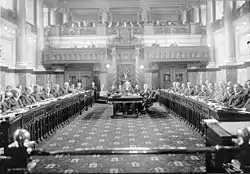1920 British Columbia general election
The 1920 British Columbia general election was the fifteenth general election for the Province of British Columbia, Canada. It was held to elect members of the Legislative Assembly of British Columbia. The election was called on October 23, 1920, and held on December 1, 1920. The new legislature met for the first time on February 8, 1921.

Although it lost eleven seats in the legislature, and fell from 50% of the popular vote to under 38%, the governing Liberal Party was able to hold on to a slim majority in the legislature for its second consecutive term in government.
The Conservative Party also lost a significant share of its popular vote, but won six additional seats for a total of fifteen, and formed the Official Opposition.
Almost a third of the vote and seven seats were won by independents and by a wide variety of fringe parties.
This was the first general election in which women could vote and run for office.
Results
| Party | Party leader | # of candidates |
Seats | Popular vote | |||||
|---|---|---|---|---|---|---|---|---|---|
| 1916 | Elected | % Change | # | % | % Change | ||||
| Liberal1 | John Oliver | 45 | 36 | 25 | -30.6% | 134,167 | 37.89% | -12.11% | |
| Conservative | William John Bowser | 42 | 9 | 15 | +66.7% | 110,475 | 31.20% | -9.32% | |
| Independent2 | 18 | 1 | 3 | +200% | 36,736 | 10.37% | +7.63% | ||
| Federated Labour3 | 14 | * | 3 | * | 32,230 | 9.10% | * | ||
| People's | 1 | * | 1 | * | 1,354 | 0.38% | * | ||
| Socialist4 | 7 | - | - | - | 12,386 | 3.50% | +2.33% | ||
| Soldier-Farmer/Soldier-Labour5 | 11 | * | - | * | 10,780 | 3.04% | * | ||
| Grand Army of United Veterans6 | 2 | * | - | * | 5,441 | 1.54% | * | ||
| } | Independent Liberal | 3 | - | - | - | 3,433 | 0.97% | +0.13% | |
| United Farmers | 2 | * | - | * | 3,178 | 0.90% | * | ||
| } | Independent Conservative | 2 | - | - | - | 1,602 | 0.45% | -1.23% | |
| } | Independent Soldier | 2 | * | - | * | 907 | 0.26% | * | |
| } | Independent Farmer | 3 | * | - | * | 526 | 0.15% | * | |
| Liberal/Conservative | 1 | * | - | * | 424 | 0.12% | * | ||
| } | Independent Socialist | 1 | 1 | - | -100% | 419 | 0.12% | -0.62% | |
| } | Independent Labour | 1 | - | - | - | 30 | 0.01% | -1.65% | |
| Total | 155 | 47 | 47 | - | 354,088 | 100% | |||
| Source: Elections BC | |||||||||
Notes:
* Party did not nominate candidates in the previous election.
1 Liberals: One member elected by acclamation. One candidate, J. Oliver, who contested and was elected in both Delta and Victoria City is counted twice.
2 Includes Liberty League of B.C., Vancouver Ratepayers Association, and Women's Freedom League candidates.
3 Includes those candidates not directly nominated by, but supported by the Federated Labour Party.
4 Includes the Prince Rupert Labour candidate running on a Socialist Party platform.
5 Sometimes referred to as a triple alliance of "Farmer-Labour-Soldier" with Soldier-Farmer candidates running in rural Districts (five candidates, 3361 votes) and Soldier-Labour candidates running in urban ones (six candidates, 7419 votes).
6 Some GAUV candidates ran on a joint Soldier-Labour ticket.
Results by riding
All districts' elections were held as first past the post, except in Vancouver City (where six seats were filled through block voting) and Victoria City (where four seats were filled through block voting).
Further reading & references
- In the Sea of Sterile Mountains: The Chinese in British Columbia, Joseph Morton, J.J. Douglas, Vancouver (1974). Despite its title, a fairly thorough account of the politicians and electoral politics in early BC.